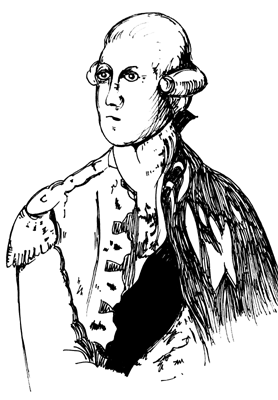 |
 |
|||
|
|
William was the third son of Frederick Louis, Prince of Wales, by Augusta, daughter of Duke Frederick II of Saxe-Gotha, and the grandson of King George II of Great Britain. As his grandfather was not on speaking terms with his parents, Prince William, as he was simply styled during his minority, grew up in the seclusion of his father's country estate at Park Place at Remenham (Berkshire). Here he was educated with the same strictness as his elder brother, George William Frederick (afterwards King George III), whom he resembled in the sobriety of his character. He was understood to be the King's favourite brother and shared, with Prince Edward Augustus, the Duke of York, the function of leading the bride to the altar at the Royal nuptials on 8th September 1761. On 27th May 1762, Prince William was elected and, on 22nd September, installed as a Knight of the Garter and, the following year, was appointed Ranger of Hampton Court. On 19th November 1764, he was created Duke of Gloucester and Edinburgh and Earl of Connaught, and was sworn onto the Privy Council exactly a month later. He took his seat in the House of Lords on 10th January 1765. In the army, Gloucester was commissioned a Colonel of the 13th Regiment of Foot on 28th June 1766, of the 3rd Regiment of Foot Guards on 6th January 1768, of the 1st Regiment of Foot Guards and Major-General on 30th March 1770, General on 25th May 1772 and, eventually, Field-Marshal in 1793. The Duke of Gloucester is, however, chiefly known for his clandestine marriage which took place during this period. On 6th September 1766, he was joined in union with Maria, the Dowager Countess Waldegrave, a lady of equal beauty and wit and the illegitimate daughter of Hon. Edward Walpole of Frogmore House. The rite was solemnized privately, by the lady’s chaplain at her house in Pall Mall, no other persons being present. The Duke rented the Manor Lodge (Old Windsor), on the Virginia Water Stream in Windsor Great Park, and, of course, as they were constantly together, gossip about the couple became widespread. Soon afterwards, in September 1767, Gloucester succeeded the Duke of York as Ranger of Cranbourne Chase and moved into his official residence at Cranbourne Lodge. This was followed by appointments as Warden of the New Forest in January 1771 and Chancellor of the University of Dublin later the same year. Meanwhile, though the court had its suspicions, the Duke’s marriage continued to be kept secret. Then, in March 1772, the King had the Royal Marriage Act passed in disgust at his discovering that another brother, the Duke of Cumberland, was married to a well-known party animal named Mrs. Horton! Sympathy with Cumberland induced the Duke of Gloucester to notify George III of own his prior offence on 16th September 1772. The King at once banished him from court, and directed an inquiry into the validity of the marriage. The Duke and Duchess were accordingly examined before three commissioners on 23rd May 1773. They swore to the fact of the marriage and its validity was allowed, though, as the chaplain who had officiated was dead, it remained unattested by any third party. Despondent, the Duke of Gloucester tried to keep himself busy by making improvements to both house and grounds at his new home, ‘Forest’ or ‘Gloucester Lodge’ on St. Leonard's Hill near Windsor, which his wife had purchased some years before. The Duke also bought the ‘Hermitage’ adjoining and renamed it as 'Sophia Farm' (now 'St. Leonard's') in honour of his eldest daughter, born only six days after the couple appeared before the Royal Commissioners. However, debts eventually forced the family into a self-imposed exile abroad, chiefly in Italy; and here their son, Prince William, was born in 1776. It was not until 1778 that provision was made for these Royal children, but money granted them by George III paved the way for Gloucester’s complete restoration to the Royal favour in June 1780. In that same year, he was elected a Fellow of the Royal Society. William and Maria ten sold their twin St. Leonard's estates for the princely sum of £10,000 but, afterwards, relations between the two appear to have begun to deteriorate. In later life, the Duke started an affair with the Duchess's lady of the bedchamber, Lady Almeria Carpenter and, by 1787, the year that the Duke received the degree of LL.D. from the University of Cambridge, the Royal couple decided upon a separation, after a dispute over their daughter's education. The Duke of Gloucester died on 25th August 1805 and was buried in St. George's Chapel, Windsor. By the Duchess, who died in 1807, Gloucester left issue: (1) Sophia Matilda, born on 29 May 1773, died unmarried on 29th November 1844, having for many years held the Rangership of Greenwich Park; (2) William Frederick, born 15th January 1776, who succeeded him in the Duchy of Gloucester. Edited from Sidney Lee's 'Dictionary of National Biography' (1899)
|
|||
| © Nash Ford Publishing 2003. All Rights Reserved. | ||||



 Prince
William Henry,
Prince
William Henry,